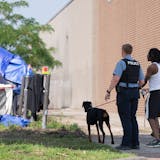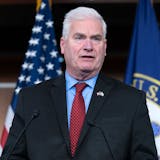Opinion editor's note: Star Tribune Opinion publishes a mix of national and local commentaries online and in print each day. To contribute, click here.
•••
It was close to 9 p.m. on a Saturday in early December 2020. My son, then 4, and I were putting the finishing touches on our Christmas tree as "How the Grinch Stole Christmas" played in the background.
That's when the sound of voices amplified by bullhorns first penetrated our living room. The peace, serenity and holiday spirit of the evening broke as a group of about 20 protesters — some of whom were armed, I later learned from the Michigan State Police — gathered outside my home. The protesters, who believed the lie that the November 2020 election had been stolen from Donald Trump, woke our neighbors with a string of threats, vitriol and provocations. They screamed for me to "come outside" and show myself so that they could confront me about doing my duty as secretary of state and chief election officer and refusing to overturn the results of the 2020 presidential election in Michigan — which President Joe Biden won by more than 154,000 votes. "No audit, no peace," they yelled.
I carried my son upstairs and ran bath water loudly to drown out the noise. I worked to stay calm, but I was acutely aware that only one unarmed neighborhood security guard on my front porch stood between my family and the growing crowd. Would the protesters attempt to enter my home? Would a stray bullet enter or ricochet into my son's bedroom? How long until law enforcement arrived? What would happen when it did?
I thought back to that evening when I saw the recent images of people gathering for candlelight vigils outside the homes of U.S. Supreme Court Justices Brett Kavanaugh, Samuel Alito and John Roberts to express their opposition to the leaked draft opinion suggesting an end to the right to abortion in America. By all accounts, these abortion rights demonstrations have been peaceful, and no one was armed or posed an imminent threat. Still, I found the images alarming.
Protest is a kind of theater, as abortion rights activists who dressed as characters from "The Handmaid's Tale" outside the home of Justice Amy Coney Barrett know. The performance is not just for the target of the protests but also for anyone who sees it via news images or video or social media. The fact is, a group of people targeting just one person, at home, particularly at night, appears menacing. That's true even if that person is one of the nine most powerful judges in the country or is Michigan's secretary of state.
The location of the protests, outside the homes of public officials, is the point critics have seized on to denounce them. Gov. Glenn Youngkin of Virginia has criticized the protests and asked the federal government to take action against those who engage in them. Florida's lawmakers went so far as to ban "picketing and protesting" at any person's private residence; when signing the bill, Gov. Ron DeSantis used fiery language about banning "unruly mobs" and "angry crowds."

